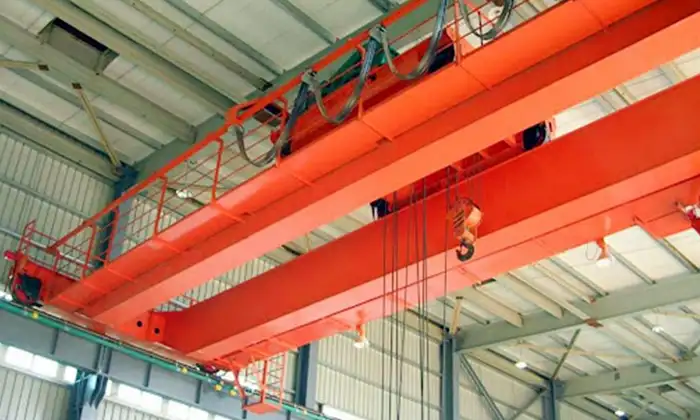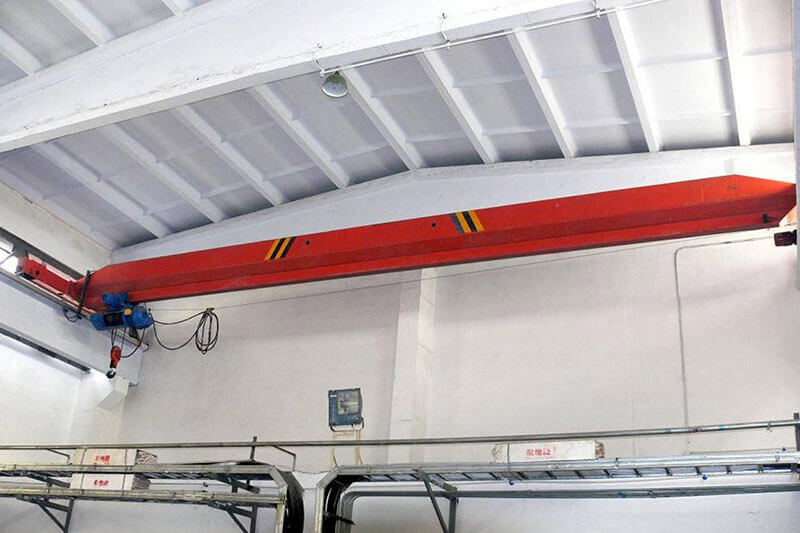Designing Overhead Cranes for Hazardous and Extreme Environments
Key Design Features of Overhead Cranes for Hazardous, Corrosive, and Extreme Environments: Ensuring Safety and Reliability
Overhead cranes are crucial for many industries, especially those dealing with hazardous and extreme environments. These industries—such as oil and gas, mining, and chemicals—require specialized crane designs that can handle volatile conditions, including explosive gases, corrosive substances, and extreme temperatures. This article will explore the unique design features of cranes built to withstand such environments, as well as showcase real-world case studies from these industries.
The aim of this blog is to highlight how overhead cranes are engineered for safety and reliability in hazardous settings, ensuring that operations can continue smoothly, even under the toughest conditions.
double girder overhead crane with explosion proof design for hazardous Environments
Hazardous and Extreme Environments
Explosive Environments
In industries like oil and gas, there is a constant risk of explosive gases and vapors in the air. These hazardous conditions can lead to fires or explosions if not properly managed. Therefore, overhead cranes used in these environments need to be designed to operate safely without causing sparks or heat that could ignite dangerous materials.
- Common examples: Offshore oil rigs, refineries, gas plants.
- Risk factors: Flammable gases, vapors, dust particles.
Corrosive Environments
Corrosion is a significant concern when cranes are used in environments where saltwater, chemicals, or other corrosive agents are present. Over time, exposure to these elements can weaken metal components, leading to costly repairs and downtime. Cranes in such environments must be built with corrosion-resistant materials and coatings to protect against rust and deterioration.
- Common examples: Chemical plants, coastal areas, marine operations.
- Risk factors: Saltwater, acids, industrial chemicals.
Extreme Temperature Conditions
Whether in extremely hot or cold conditions, overhead cranes must maintain their strength and functionality. High-temperature environments—like steel mills or foundries—can cause materials to lose their strength and cause failure if cranes aren’t designed to handle the heat. Similarly, in freezing environments, parts can become brittle, leading to equipment breakdowns.
- Common examples: Steel mills, Arctic or high-altitude locations, refrigerated warehouses.
- Risk factors: Extreme heat, freezing temperatures, fluctuating temperature conditions.
Key Design Features for Hazardous and Extreme Environments
Explosion-Proof Design
For environments with explosive gases, fumes, or dust, cranes must have explosion-proof components to ensure that no sparks or electrical malfunctions ignite the atmosphere. These cranes are often designed with airtight electrical enclosures, flameproof wiring, and other safety features to contain any potential explosion.
Key features:
- ATEX and IECEx certification for explosion-proof equipment.
- Flameproof electrical enclosures to prevent sparks.
- Spark-resistant materials and components.
Corrosion Resistance
Crane designs for corrosive environments are built using materials that prevent rust and damage from chemicals, saltwater, and other corrosive substances. Stainless steel, galvanized coatings, and specialized paints are commonly used to protect crane structures and prolong their lifespan.
Key materials:
- Stainless steel and galvanized coatings for long-lasting protection.
- Special anti-corrosion paints and coatings for enhanced durability.
- Regular maintenance and inspection schedules to prevent corrosion build-up.
Temperature Resistance
Crane systems designed for extreme temperatures must use materials and coatings that prevent structural degradation. High-temperature cranes often feature heat-resistant coatings and specialized alloys to ensure that the crane can operate safely in hot environments. Conversely, cranes used in cold environments need lubricants and materials that won’t freeze or crack in low temperatures.
High-temperature cranes:
- Heat-resistant coatings and alloys for elevated temperatures.
- Insulation and cooling systems to protect critical components.
Cold-temperature cranes:
- Low-temperature lubricants that maintain fluidity in freezing conditions.
- Special materials that do not become brittle in sub-zero temperatures.
Crane Safety Considerations for Hazardous Environments
Safety Standards and Certifications
To ensure overhead cranes can safely operate in hazardous environments, they must comply with strict safety standards and certifications. These include global standards like ISO, ASME, and ATEX, which define the requirements for cranes used in explosive, corrosive, and extreme temperature conditions. Regular inspections and certifications are mandatory to confirm that the cranes remain safe and compliant throughout their lifecycle.
Key standards:
- ISO 9001 for general safety.
- ATEX certification for explosive environments.
- ASME B30.2 for overhead crane safety.
Safety Features
Safety is paramount in hazardous environments, and cranes are equipped with a variety of safety features to protect operators and prevent accidents. These include overload protection to prevent lifting beyond the crane’s capacity, emergency stop systems, and limit switches to ensure cranes operate within safe boundaries. Furthermore, fire suppression systems and remote operation controls are often integrated for additional safety.
Key safety features:
- Overload protection to prevent dangerous lifting.
- Emergency stop systems for immediate response in case of issues.
- Limit switches to ensure safe movement within defined limits.
- Fire suppression systems to quickly address potential fires.
Case Studies: Cranes in the Oil and Gas, Mining, and Chemical Industries
Oil and Gas Industry
In the oil and gas industry, cranes are used in environments where explosive gases and liquids are present. Offshore oil rigs, for example, rely on cranes that are specially designed to prevent sparks and electrical malfunctions that could ignite volatile gases. These cranes are often required to handle large equipment, such as drilling pipes and tanks, and must be capable of withstanding harsh weather conditions and corrosive saltwater.
- Example: Offshore oil rig crane lifting heavy drilling equipment.
- Design features: Explosion-proof electrical systems, corrosion-resistant materials, weather-resistant coatings.
Mining Industry
The mining industry requires cranes to operate in dusty, high-humidity environments, often underground or in remote locations. In these settings, cranes must be designed to lift heavy materials, such as ores, tools, and machinery, while protecting against corrosion and maintaining reliable performance despite the harsh conditions. Overhead cranes used in mining operations are built to withstand dust, moisture, and exposure to chemicals like sulfur and acids.
- Example: Overhead crane in an underground mine lifting mining tools.
- Design features: Dust-resistant, corrosion-proof materials, enhanced load capacity.
Chemical Industry
Cranes used in the chemical industry must be explosion-proof and resistant to corrosive chemicals, such as acids, bases, and solvents. These cranes are often used to move large chemical containers or equipment that can be hazardous if mishandled. The crane's design ensures that it does not trigger any chemical reactions or ignite dangerous substances.
- Example: Crane handling hazardous chemicals in a chemical processing plant.
- Design features: Explosion-proof components, corrosion-resistant coatings, safety features to prevent chemical spillage.
Explosion proof overhead crane single girder design
Benefits of Specialized Overhead Cranes for Hazardous and Extreme Environments
Increased Safety
By integrating advanced safety features and complying with strict regulations, overhead cranes in hazardous environments significantly reduce the risk of accidents and injuries. These cranes are designed to operate safely even in the most dangerous conditions, ensuring worker safety and preventing damage to equipment.
Key benefits:
- Compliance with safety standards for worker protection.
- Reduced accident risk through explosion-proof and corrosion-resistant designs.
- Enhanced fire and emergency response systems.
Improved Efficiency and Reliability
Specialized cranes are built to function in challenging environments without frequent breakdowns. Their robust design ensures they can handle heavy loads and extreme conditions without interruption, which helps keep operations running smoothly and efficiently.
Key benefits:
- Increased uptime and reduced downtime due to reliable operation.
- Improved load handling and operational efficiency.
- Long-lasting design that supports high-frequency lifting.
Longevity and Reduced Maintenance Costs
By using durable materials and coatings, overhead cranes built for hazardous environments are more resistant to wear and tear. This leads to fewer maintenance requirements, longer service life, and lower overall operating costs for companies.
Key benefits:
- Longer crane lifespan due to corrosion-resistant materials.
- Reduced need for frequent repairs and replacements.
- Lower total cost of ownership and higher ROI over time.
6. Future Trends in Overhead Cranes for Hazardous Environments
Innovative Materials and Coatings
As technology advances, new materials and coatings are being developed to improve the performance and durability of cranes in hazardous environments. These innovations aim to offer even better protection against corrosion, heat, and wear, making cranes more reliable and longer-lasting.
Innovations to watch:
- Next-generation anti-corrosion materials.
- High-temperature alloys for extreme heat environments.
- Lightweight materials that maintain strength in harsh conditions.
Automation and Remote Monitoring
Automation is transforming the way cranes operate in hazardous environments. Remote monitoring allows operators to track crane performance from a safe distance, enabling predictive maintenance and real-time troubleshooting. This reduces the need for direct operator involvement in risky conditions.
Future features:
- Remote monitoring of crane status and performance.
- Predictive maintenance using AI and machine learning.
- Increased use of autonomous cranes for safer, more efficient operations.
Sustainability
As industries focus more on sustainability, crane manufacturers are increasingly looking for ways to reduce environmental impact. This includes using eco-friendly materials, designing energy-efficient cranes, and minimizing waste throughout the crane’s lifecycle.
Sustainable practices:
- Eco-friendly coatings and materials.
- Energy-efficient crane motors and control systems.
- Recycling and reusing materials for crane construction.
Conclusion
Overhead cranes designed for hazardous and extreme environments play a critical role in industries where safety, efficiency, and durability are paramount. By incorporating explosion-proof designs, corrosion-resistant materials, and temperature-resistant components, these cranes can handle the toughest working conditions while ensuring worker safety. As technology continues to evolve, we can expect even more innovative features and designs to improve crane performance and reliability in hazardous environments.





